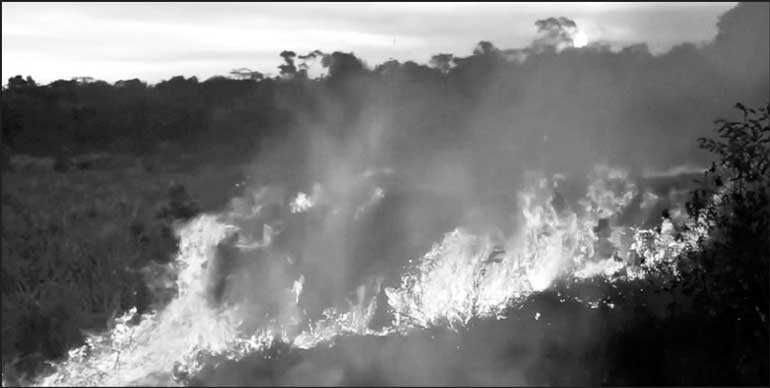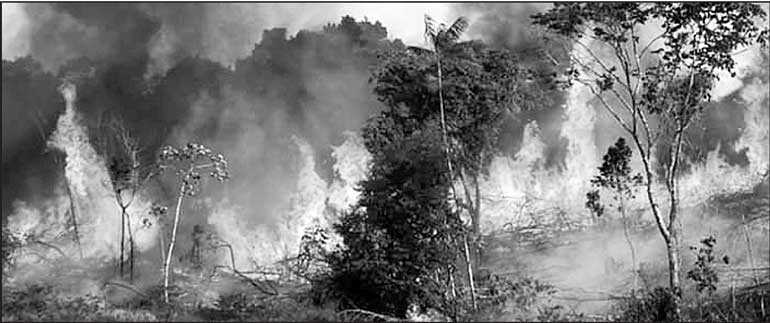Saturday Mar 15, 2025
Saturday Mar 15, 2025
Saturday, 24 August 2019 00:05 - - {{hitsCtrl.values.hits}}

The Amazon rainforest fires have been raging for three weeks

The topic of forest fires in Sri Lanka needs urgent addressing. Pictured here, a reserve in the Ella rock region engulfed in flames
By the Harmony page team
The Amazon rainforest fires have been raging for three weeks, largely out of media focus. This is one of the most devastating fires in the Amazon rainforest located in Brazil and is seen as a climate emergency. Pictures published by NASA on Thursday and Friday showed smoke and fire in the Amazonas, Mato Grosso and the Rodonia states of Brazil.
The Amazon rainforest, the most valuable green treasure of the world’s eco system having a third of all known terrestrial, animal and plant species, expands across 5.5 square kilometres, and surrounds the Amazon River which contains 20% of the world’s flowing freshwater. Although the Amazon rainforest is in general wet and humid, July and August are months that are prone to forest fires because they are the region’s driest months of the year and the susceptibility of fires is high as a result of human action such as farming and ranching where fire is used to clear land.
The Express newspaper in the United Kingdom in a report Thursday said that NASA fears that new wildfires will accelerate warming of the climate and warned that there is another wildfire threat in the offing in the boreal forests of Canada. According to the Express, this warning was given after a NASA-funded study of wildfires in the Canadian Northwest territories ‘found a ticking time bomb threatening to release generations’ old carbon deposits trapped in the soil.
Overall analysts say the number of forest fires have been increasing at an alarming rate in the world. According to Satellite data of the National Institute for Space Research, an 84% increase in forest fires was seen in 2018 and the year 2019 thus far, has seen more than double the number of forest fires in Brazil than in 2013. Up to now (August) this year 75,000 forest fires have occurred in the Amazon.
The BBC reported the head of the World Wide Fund for Nature (WWF), Ricardo Mello as saying that the fires were a consequence of the increase in deforestation seen in recent figures. The World Meteorological Organization, the United Nation’s weather arm said on twitter Thursday that fires release pollutants including particulate matter and toxic gases such as carbon monoxide, nitrogen oxides, and non-methane organic compounds into the atmosphere.
According to reports the European Union’s Earth Observation Program’s Sentinel satellites have captured the images of ‘significant amounts of smoke’ over Amazonas, Rodonia and other areas. The Rainforest Foundation of Norway that works with indigenous communities and others who live around the Amazon rainforest, to work on protecting the forest cover from harmful human activity, warned that up to 65% of the Amazon is in danger of ‘being turned into a savannah’ in the course of the next 50 years. The organisation also said in its website that much of the loss of forest cover since 1950s were due to cattle ranching, farming, oil, gas production, mining, logging and other diverse infrastructure projects.
Global media attention on the forest fires began in earnestness only in the latter part of this week, three weeks after the global tragedy began raging in the Amazon. The Amazon produces more than 50% of all the rain that falls in the region and around 20% of the earth’s oxygen. It contains 10% of the earth’s biomass which means it stores vast amounts of carbon that gets released into the surrounding atmosphere when deforestation takes place, creating the vicious cycle of global warming that has the world desperately now taking to ‘artificial rain’ in some parts of the world, as a last resort to escaping from the bad karma of man to his only home which is this planet.
The fact that man’s detrimental actions return to humankind through climate disasters was seen when the Al Jazeera news agency Thursday reported how indigenous families were finding their homes being eaten up by the flames that leaped across the Amazon. The agency quoted cacao growers living in the periphery of the forest who described the damage as ‘irreversible’.
The states of Amazonas, Rondonia, Acre, Para and Mata Grosso du sol were some of the most affected areas and most of the burning happens insight the Amazon rainforest, the Al Jazeera said adding that in the span of a mere week 9,507 new forest fires were detected in the Amazon. Flights were being cancelled and people were being hospitalised following respiratory problems as a result of the smoke choking vast areas and the smoke travelling over 2,500 km away had cloaked the sky over Sao Paulo in black.
Deforestation has been cited as the reason for the increase in forest fires by Alen Alencar, Director of Science in the Amazon Environmental Research Institute. The Al Jazeera news agency quoted Alencar’s explanation of deforestation as the reason for the fires while indigenous reservations were reportedly among the most affected, not only by the immediate threats to their homes and health but also a possible dying of resources such as animals and rivers and fish that the communities depend on for their livelihood.
The sad scorching of the Amazon rainforest holds a mirror to the world on what is happening around the planet, where forests are felled without a care, where as a result rainfall as well as ground water is gradually deteriorating and all forms of abnormal climatic reactions plaguing man. The eco system of the planet is connected to the wellbeing of each human and whether it is plant or animal species that are getting extinguished from the planet as a result of actions of humans, the human race is finally the victim.
Let these latest fires in the Amazon remind us of the threat we are facing and each of us take the responsibility to plant a tree where each of us can, and when possible assist initiatives of reforestation in our country and wherever else we can.
The topic of forest fires in Sri Lanka needs urgent addressing. In July this year over 500 acres were burnt down in Sri Lanka in the Monaragala district and few people arrested over causing the fire. The Sunday Times in Sri Lanka reporting on the fires last month quoted Disaster Management Centre Assistant District Director A.H. Ravindra Kumara who stated that farmers in Sri Lanka burn up to 60 acres of forest cover to cultivate crops such as corn. Forest fires are also associated with hunting of wild animals and search for timber where fire is set to the base of trees as a way of felling them.
In the July forest fire in Sri Lanka, alarm bells were raised by E.L.M. Udaya Kumara, the DMC Assistant Director for Badulla who warned that forest fires contaminating the many water bodies running through Badulla would spell calamity.
The military spokesman Brigadier Sumith Attapattu said that the army was assisting in the operations of putting out the fire. Thursday evening also saw the Moneragala Maragala rock forest reserve going up in flames but was subsequently put out by the efforts of the DMC, the military and the police. At least 30 acres have been burnt in the Maragala rock reserve as a result of this fire, sources said. The exact origin of the fire was hard to immediately assert
Friday saw the Ella rock area in the Badulla district in Sri Lanka engulfed in fire. The fire had started raging on 22 August and continued up to 23 August, largely out of the media spotlight. By Friday morning the fire had reached the Ravava Ella falls, eyewitness accounts said, stating that the fire was visible from afar showing rings of fires encircling the Ella rock forest reserve area. The eruption of the fire in a precipice had made the dousing of the fire difficult and flames were eating into the biosphere of the area till evening, the time of this page going into print. The military spokesman Brigadier Sumith Attapattu said that the army was assisting in the operations of putting out the fire. Thursday evening also saw the Moneragala Maragala rock forest reserve going up in flames but was subsequently put out by the efforts of the DMC, the military and the police. At least 30 acres have been burnt in the Maragala rock reserve as a result of this fire, sources said. The exact origin of the fire was hard to immediately assert.
In this global and local backdrop there is an urgent need to educate ourselves and our communities that a forest fire is an instant extinction of not only plant life but hundreds of animal species that keep the balance of our ecosystem and the slow extinction of man himself.
Friday saw the Ella rock area in the Badulla district in Sri Lanka engulfed in fire. The fire had started raging on 22 August and continued up to 23 August, largely out of the media spotlight. By Friday morning the fire had reached the Ravava Ella falls, eyewitness accounts said, stating that the fire was visible from afar showing rings of fires encircling the Ella rock forest reserve area. The eruption of the fire in a precipice had made the dousing of the fire difficult and flames were eating into the biosphere of the area till evening, the time of this page going into print
References:
The website of the Rainforest Foundation Norway: https://www.regnskog.no/en/
Website: www.cnbc.com (https://www.cnbc.com/video/ 2019/08/21/record-breaking- number-of-fires-burn-in- brazils-amazon.html)
Website www.cnet.com (https://www.cnet.com/how-to/ the-amazon-rainforest-is-on- fire-what-we-know-so-far-and- how-you-can-help/)
The Express, UK (https://www.express.co.uk/ news/science/1169046/Amazon- rainforest-fires-NASA- wildfires-Canada-boreal- forest-fires-carbon-climate- change)
The Sunday Times of Sri Lanka (http://www.sundaytimes.lk/ 190714/news/sri-lankans-spark- most-destructive-forest-fires- 358106.html)
www. bbc.com
Discover Kapruka, the leading online shopping platform in Sri Lanka, where you can conveniently send Gifts and Flowers to your loved ones for any event including Valentine ’s Day. Explore a wide range of popular Shopping Categories on Kapruka, including Toys, Groceries, Electronics, Birthday Cakes, Fruits, Chocolates, Flower Bouquets, Clothing, Watches, Lingerie, Gift Sets and Jewellery. Also if you’re interested in selling with Kapruka, Partner Central by Kapruka is the best solution to start with. Moreover, through Kapruka Global Shop, you can also enjoy the convenience of purchasing products from renowned platforms like Amazon and eBay and have them delivered to Sri Lanka.
Discover Kapruka, the leading online shopping platform in Sri Lanka, where you can conveniently send Gifts and Flowers to your loved ones for any event including Valentine ’s Day. Explore a wide range of popular Shopping Categories on Kapruka, including Toys, Groceries, Electronics, Birthday Cakes, Fruits, Chocolates, Flower Bouquets, Clothing, Watches, Lingerie, Gift Sets and Jewellery. Also if you’re interested in selling with Kapruka, Partner Central by Kapruka is the best solution to start with. Moreover, through Kapruka Global Shop, you can also enjoy the convenience of purchasing products from renowned platforms like Amazon and eBay and have them delivered to Sri Lanka.